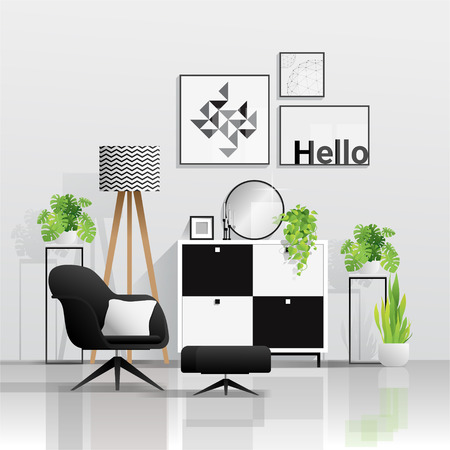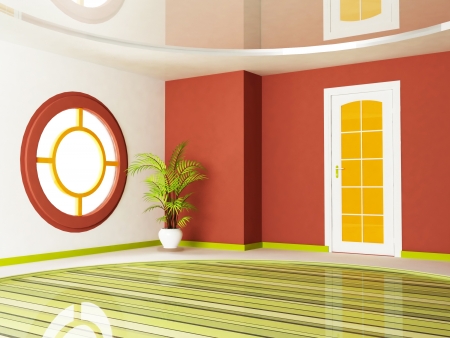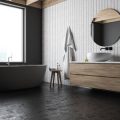1. Understanding Color Temperature
If you’re setting up a home office, chances are you’ve come across the term “color temperature.” But what does it really mean? Color temperature is a way to describe the appearance of light provided by a bulb, measured in Kelvins (K). Imagine it as a sliding scale: on one end, you have warm, cozy tones like an old-school diner’s pendant lamp (think 2700K to 3000K), and on the other, you’ve got crisp daylight vibes—like a clear morning in downtown Seattle (around 5000K to 6500K).
Here’s the lowdown: Warm light (lower Kelvin numbers) gives off a soft, yellowish glow. It’s great for relaxing and unwinding—picture your grandma’s living room lamp or a vintage filament bulb at your favorite coffee joint. Cool light (higher Kelvin numbers), on the flip side, emits a bluish-white tone that feels fresh and alert, much like the fluorescence of an open-plan office or a modern art gallery.
To keep things simple, remember these terms: “warm white” usually means lighting below 3500K; “cool white” is 3500K to 5000K; and “daylight” typically clocks in above 5000K. Each type sets its own mood and impacts how you feel while working from home. Don’t worry if these numbers sound technical—once you know the basics, choosing the right glow for your workspace is a breeze.
2. How Color Temperature Influences Productivity
When it comes to home office lighting, the color temperature of your light source plays a pivotal role in shaping how productive, alert, and motivated you feel during the workday. Research suggests that different color temperatures—measured in Kelvin (K)—can significantly affect our focus, mood, and energy levels, all of which are crucial for a successful American work-from-home routine.
Research Insights on Color Temperature and Work Performance
Studies from institutions such as the Lighting Research Center at Rensselaer Polytechnic Institute highlight that cooler light (higher Kelvin values) tends to boost alertness and cognitive function. On the other hand, warmer light (lower Kelvin values) can promote relaxation but may make it harder to stay sharp during tasks requiring sustained attention—something many remote workers notice when tackling those Monday morning reports or afternoon Zoom meetings.
Color Temperature Effects Throughout the Typical American Workday
| Time of Day | Recommended Color Temperature | Impact on Mood & Productivity | Example Activity |
|---|---|---|---|
| Early Morning (8–10 AM) | 4000K–5000K (Cool White) | Boosts alertness; helps shake off grogginess | Email review, daily planning |
| Midday (10 AM–2 PM) | 5000K–6500K (Daylight) | Keeps energy high; enhances focus for deep work | Project work, video calls |
| Afternoon (2–5 PM) | 3500K–4500K (Neutral White) | Sustains concentration; reduces eye strain as natural light fades | Meetings, collaborative tasks |
| Evening (After 5 PM) | 2700K–3000K (Warm White) | Promotes relaxation; helps transition to personal time | Tidying up, prepping for next day |
A Trend Toward Dynamic Lighting Solutions
The modern American home office is seeing a rise in dynamic LED lighting systems that adjust color temperature throughout the day. This mirrors natural sunlight patterns and supports our circadian rhythms—a trend especially popular among tech-savvy professionals aiming for optimal productivity and well-being. By tuning your workspace lighting to match your work schedule, you can harness these research-backed benefits and create a home office environment thats both comfortable and energizing.

3. Choosing the Right Color Temperature for Your Home Office
When it comes to optimizing your home office lighting, selecting the right color temperature is more than just a matter of taste—it can make or break your productivity and comfort. In typical American homes, offices are often set up in spare bedrooms, basements, or dedicated dens. Each space comes with its own quirks: some bask in plenty of natural daylight, while others rely mainly on artificial lighting. So, how do you choose the perfect color temperature?
Consider the Function of Your Space
Start by thinking about how you use your home office. If your work involves lots of reading, video conferencing, or detailed tasks, opt for a cooler white light (around 4000K to 5000K). This mimics daylight and keeps you alert—a must-have for those long Zoom calls or spreadsheet marathons. On the flip side, if your office doubles as a cozy study or creative nook where you wind down in the evenings, a warmer light (2700K to 3000K) can create a more relaxed atmosphere.
Account for Daylight Availability
Is your office space blessed with big windows facing south or west? If so, you’re likely getting plenty of natural sunlight during the day. In this case, choose adjustable LED bulbs that let you shift from cool to warm tones as the sun moves—these are especially handy in open-concept homes or rooms with variable daylight. For windowless rooms or basements common in many American houses, lean towards cooler temperatures to simulate natural light and ward off drowsiness.
Personal Preferences Matter
No two home offices—or people—are exactly alike. Some folks thrive under bright, crisp lighting, while others find it harsh and prefer softer hues. Experiment with different bulbs and fixtures until you strike the right balance between clarity and comfort. Smart bulbs and dimmable LEDs are popular choices in the States because they offer flexibility for every mood and task throughout the day.
By tailoring your lighting setup to your room’s function, available daylight, and personal style, you’ll create a home office environment that’s both energizing and inviting—right in tune with modern American living.
4. Mixing and Matching Light Sources
When it comes to achieving optimal comfort and efficiency in your home office, mixing and matching different light sources is a true game-changer. Most American households rely on a blend of LEDs, smart bulbs, and trusty desk lamps—each offering unique benefits depending on the task at hand and the time of day.
Common Lighting Options in American Homes
| Light Source | Best For | Color Temperature Range | Pros | Cons |
|---|---|---|---|---|
| LED Bulbs | General Overhead Lighting | 2700K-6500K | Energy-efficient, Long-lasting, Variety of options | Some cheap models can flicker or have harsh color rendering |
| Smart Bulbs | Adjustable Ambiance & Mood Lighting | 2000K-6500K (tunable) | Customizable, App/voice control, Schedules & automation | Requires Wi-Fi/hub, Higher upfront cost |
| Desk Lamps | Task Lighting for Workspaces | 3000K-5000K (often adjustable) | Focused illumination, Portable, Dimmable options available | Covers limited area, Needs outlet or batteries |
How to Blend Light Sources for Comfort and Productivity
- Create Layers: Use overhead LEDs for general illumination, then add a desk lamp with a cooler temperature for focused tasks. Smart bulbs can fill in the gaps or set the mood when needed.
- Tune Color Temperatures: During daytime hours, lean into cooler (4000K–5000K) lights to boost alertness. As evening approaches, shift toward warmer tones (2700K–3000K) to help your body wind down.
Transitioning Between Day and Night Lighting Needs
- If you use smart bulbs or tunable LEDs, set schedules that gradually adjust color temperature as the day progresses—mimicking natural daylight shifts.
- No smart tech? Manually switch from cool white desk lamp to a warm white lamp in the evening to reduce eye strain and promote relaxation after work hours.
A Quick Reference Guide for Home Office Lighting Transitions:
| Time of Day | Recommended Color Temp |
|---|---|
| Morning – Early Afternoon | 4000K–5000K (Cool White) |
| Late Afternoon – Evening | 2700K–3500K (Warm White) |
Merging traditional lighting wisdom with modern technology lets you curate a workspace that adapts to your rhythm—balancing vintage charm with contemporary convenience for every hour spent in your home office.
5. Health Implications of Poor Lighting Choices
When it comes to working from home, the color temperature of your office lighting isn’t just about aesthetics—it’s a matter of well-being. Poor lighting choices can take a toll on both your body and mind. Exposure to improper color temperatures, like harsh cool whites or overly warm ambers at the wrong times of day, can trigger eye strain, headaches, and even disrupt your circadian rhythm.
Eye Strain and Fatigue: Signs to Watch For
If you’ve ever noticed dry eyes, blurred vision, or frequent headaches after hours at your desk, your lighting might be to blame. Light that’s too blue (cool) or too yellow (warm) makes your eyes work overtime, especially when bouncing off screens and paperwork. Inconsistent lighting can cause you to squint or lean in closer—classic signs that your setup needs a tweak.
Sleep Disruption: The Hidden Hazard
It’s not just your eyes at risk. Working late under cool, daylight-mimicking bulbs may trick your brain into thinking it’s still daytime, suppressing melatonin production and making it harder to wind down for bed. Over time, this can mess with your sleep quality—leaving you groggy and less productive come morning.
Remedying Lighting-Related Health Issues
To keep these issues in check, start by matching your lighting to the time of day: use cooler, brighter lights during morning and midday for alertness; shift to warmer tones as evening approaches to cue relaxation. Invest in adjustable LED fixtures or smart bulbs that let you dial in the right temperature on demand. And don’t forget regular screen breaks—give your eyes a chance to reset every hour. By tuning into these subtle signals and making small adjustments, you’ll craft a workspace that supports both your workflow and your health.
6. Trendy Lighting Solutions for the Modern Home Office
Today’s American home offices aren’t just about a desk and a chair—they’re dynamic spaces where cutting-edge lighting meets personal style and productivity. As remote work becomes the new normal, homeowners are investing in lighting solutions that offer both functionality and flair. Let’s take a look at some of the most popular and emerging trends shaping the U.S. home office market.
Smart Lighting Systems
Smart bulbs and fixtures, like those from Philips Hue or LIFX, are all the rage in modern home offices. These systems let you control color temperature, brightness, and even scheduling from your smartphone or voice assistant. With features like tunable white light, you can switch between cool, energizing tones for work hours and warmer shades to wind down after hours—all with a simple command.
LED Desk Lamps with Adjustable Color Temperature
The classic desk lamp has gotten a major upgrade. Today’s best-sellers feature touch controls, USB charging ports, and adjustable arms for perfect positioning. Most importantly, they allow users to toggle between various color temperatures—from crisp daylight for focus-intensive tasks to softer hues for late-night reading—catering to every preference and task.
Layered Lighting Design
Aesthetics matter just as much as function in contemporary home offices. Layered lighting—combining ambient ceiling lights, task lamps, and accent fixtures—creates visual interest while ensuring optimal illumination. Popular American design trends include retro-inspired sconces, minimalist pendant lights, and LED strip lights tucked behind monitors or bookshelves for a futuristic vibe.
Wellness-Driven Lighting
Health-conscious Americans are embracing circadian rhythm lighting technologies that automatically adjust throughout the day to mimic natural sunlight patterns. These innovations support energy levels during work hours and promote relaxation as evening approaches—helping remote workers stay sharp without sacrificing well-being.
Sustainable Choices
Eco-friendly lighting is taking center stage in the U.S., with LED fixtures leading the charge for their energy efficiency and long lifespan. Many designers are also incorporating recycled materials into lamp bases and shades, reflecting an increasing demand for sustainability in home office decor.
Whether you’re upgrading your workspace or designing from scratch, today’s top lighting solutions blend high-tech features with American design sensibilities—delivering customizable comfort and undeniable style right where you need it most.


